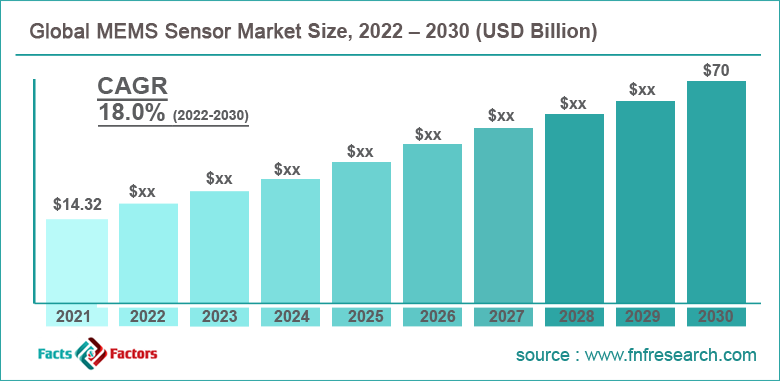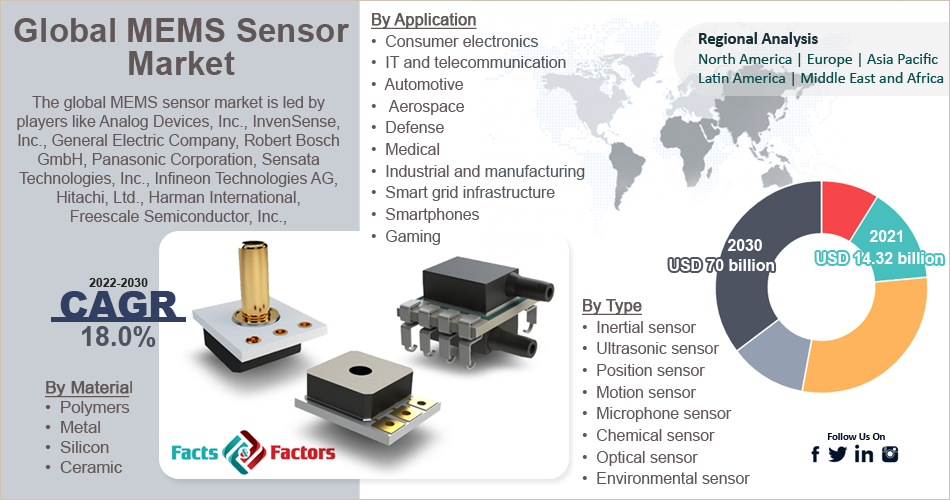Search Market Research Report
MEMS Sensor Market Size, Share Global Analysis Report, 2022 – 2030

MEMS Sensor Market Size, Share, Growth Analysis Report By Type (Inertial Sensor, Ultrasonic Sensor, Position Sensor, Motion Sensor, Microphone Sensor, Chemical Sensor, Optical Sensor, And Environmental Sensor), By Material (Polymers, Metal, Silicon, And Ceramic), By Application (Consumer Electronics, It And Telecommunication, Automotive, Aerospace, Defense, Medical, Industrial And Manufacturing, Smart Grid Infrastructure, Smartphones, Gaming, And Others), and By Region - Global and Regional Industry Insights, Overview, Comprehensive Analysis, Trends, Statistical Research, Market Intelligence, Historical Data and Forecast 2022 – 2030
Industry Insights
[212+ Pages Report] According to the report published by Facts Factors, the global MEMS Sensor market size was worth around USD 14.32 billion in 2021 and is predicted to grow to around USD 70 billion by 2030 with a compound annual growth rate (CAGR) of roughly 18% between 2022 and 2030. The report analyzes the global MEMS sensor market drivers, restraints/challenges, and the effect they have on the demands during the projection period. In addition, the report explores emerging opportunities in the MEMS sensor market.

 Market Overview
Market Overview
MEMS sensors are devices that combine mechanical and electrical elements. This technology comprises small mobile mechanical parts and electrical parts that fabricate several sensors like gyroscopes, digital compasses, accelerometers, pressure sensors, microphones, and inertial modules. The market growth is fueled by the growing need for miniaturization of devices that are used in medical instruments, wearable devices, smartphones, and several other electronic devices.
MEMS sensors are adopted on a large scale in the biomedical sector and the market growth is boosted by the increased sales of autonomous vehicles across the globe. Consumption of less space, low cost, and higher accuracy are some of the benefits that will increase the sales of these sensors. Growing concerns about vehicle safety across the world will create more demand for these sensors. Governments of various nations are engaged in formulating regulations and standards for the use of sensors in the automotive industry.
 Key Insights
Key Insights
- As per the analysis shared by the research analyst, the global MEMS sensor market is estimated to grow annually at a CAGR of around 18% over the forecast period (2022-2030)
- In terms of revenue, the global MEMS sensor market size was valued at around USD 14.32 billion in 2021 and is projected to reach USD 70 billion, by 2030.
- The market is projected to grow at a significant rate due to the growing applications in the consumer electronics and automobile industry
- By type, optical sensors witnessed the maximum market share in 2021.
- By material, the polymer used in fabrication was leading the market growth in 2021.
- By end-user, consumer electronics was the segment that generated the maximum revenue in 2021.
- By region, Asia-Pacific was the leading revenue generator in 2021

 Growth Drivers
Growth Drivers
- Growing applications in the automotive and consumer electronics industry to drive market demand
The use of these sensors has grown rapidly in the consumer electronics industry as well as in the automotive industry. Growing demand for autonomous vehicles and driverless vehicles will lead to increased consumption of MEMS sensors, especially the developed nations across the globe.
 Bio-MEMS in surgeries and medical implants.
Bio-MEMS in surgeries and medical implants.
Implantable micro electrodes help in recording and monitoring the clinical parameters. And the use of these sensors in surgical procedures is mainly due to their capability of improving the existing functions and capabilities. The risk associated with the surgeries will be reduced to a great extent due to the use of these sensors. Drug delivery is another application of bio-MEMS. Micro-needles are used for delivering drugs and the use of these microneedles reduces pain, eliminates bleeding, and reduces the damage to tissues. One of the examples of microneedles in drug delivery is its use for conjunctivitis.
 Restraints
Restraints
- Increase in the overall cost to restrict market expansion
The implementation of the sensors in various devices increases the cost of the product. The lack of standardization in the fabrication process and considerations of interface design will also prove to be some factors that may hamper the growth of the global MEMS sensors market during the forecast period.
 Opportunities
Opportunities
- These sensors are cost-effective and extremely reliable.
The robust nature of these sensors makes them reliable and due to this, the use of MEMS sensors in various industries has grown rapidly since the 20th century. Portable devices also make use of these sensors for the stabilization of optical images and navigation. These sensors are offered at a lower cost and the size is miniaturized due to which they have major applications. Sensors provide high resistance even when they are subjected to 175 degrees. This makes them widely acceptable.
 Challenges
Challenges
- Accuracy and calibration act as a major challenge
Issues related to accuracy and calibration may hamper the growth of the market during the forecast period.
 Segmentation Analysis
Segmentation Analysis
The global MEMS sensors market is segmented on the basis of type, fabrication material, application, and region.
By fabrication material, the market is divided into polymers, metal, silicon, and ceramic. The polymer fabrication material segment is projected to register a higher growth rate as compared to the other materials used for fabrication. The use of other materials like metal, silicon, and ceramic will also show significant growth in the anticipated time frame.
The application of the sensors has a wide range. The sensors are used in flexible devices and semiconductor chips. The use of polymer-fabricated sensors will register an impressive growth rate during the forecast period. This type of fabrication provides better functionality and is a novel product. The cost of this product is less as compared to the other materials used for fabrication. About 35% of the market share will be held by these sensors during the forecast period.
By application, the market is divided into consumer electronics, IT and telecommunication, automotive, aerospace, defense, medical, industrial and manufacturing, smart grid infrastructure, smartphones, gaming, and others. By application, the demand for MEMS sensors used in consumer electronics will generate a good amount of revenue in the coming years. The availability of higher disposable income has resulted in increased use of smartwatches, smartphones, and other devices.
However, the market value will be held by consumer electronics due to an increased demand for these devices, especially in the Asia-Pacific region. There are many technical applications of these sensors in the medical industry as well as in the automotive industry. Significant growth will be registered by the automotive industry as the need for autonomous cars has grown rapidly.
 Recent Developments:
Recent Developments:
- A smart sensor evaluation kit was introduced by STMicroelectronics in 2021. This device will play an extremely significant role in reducing the workload of the machines and providing easy integration with the software and increasing functionality.
- The customer base of the company Analog Devices Inc. and Synopsys will increase in the long run due to a collaboration between them in 2022. It will help them in meeting the design targets of the consumers and it will also help the organizations in developing innovative electronic systems
 Report Scope
Report Scope
Report Attribute |
Details |
Market Size in 2021 |
USD 14.32 Billion |
Projected Market Size in 2030 |
USD 70 Billion |
CAGR Growth Rate |
18% CAGR |
Base Year |
2021 |
Forecast Years |
2022-2030 |
Key Market Players |
Analog Devices Inc., InvenSense Inc., General Electric Company, Robert Bosch GmbH, Panasonic Corporation, Sensata Technologies Inc., Infineon Technologies AG, Hitachi Ltd., Harman International, Freescale Semiconductor Inc., STMicroelectronics, Murata Electronics Oy, Delphi Automotive PLC, Freescale Semiconductor Inc., and others. |
Key Segment |
By Type, Material, Application, and Region |
Major Regions Covered |
North America, Europe, Asia Pacific, Latin America, and the Middle East &, Africa |
Purchase Options |
Request customized purchase options to meet your research needs. Explore purchase options |
 Regional Analysis
Regional Analysis
- Asia-Pacific to lead with the highest CAGR during the forecast period
The Asia-Pacific region will have the largest share in the global MEMS sensors market due to increased awareness about the use of these products and technological advancement. The growing demand for electronic equipment that is eco-friendly will also help with the growth of the market. The regulatory policies in the Asia-Pacific region are favorable and compliance with such policies is easier due to which the market will flourish. Renewable infrastructure of energy has a greater demand, especially in the nations like China and India. The market for MEMS sensors in China will emerge as one of the largest markets. USD 8.1 billion in revenue will be generated in the Asia-Pacific region during the forecast period.
North American region will also see lucrative growth due to the growing demand for consumer electronics. Modern automobiles also have a great demand in the North American region. Increased sales of wearable devices will increase the consumption of MEMS sensors in the nations like Canada and the US. Regulatory policies in the North American region will play an instrumental role in developing the MEMS sensors market. 18% compound annual growth rate will be registered in North America during the time of its sales period as projected in the report.
 MEMS sensor Market: Competitive Analysis
MEMS sensor Market: Competitive Analysis
- Analog Devices Inc.
- InvenSense Inc.
- General Electric Company
- Robert Bosch GmbH
- Panasonic Corporation
- Sensata Technologies Inc.
- Infineon Technologies AG
- Hitachi Ltd.
- Harman International
- Freescale Semiconductor Inc.
- STMicroelectronics
- Murata Electronics Oy
- Delphi Automotive PLC
- Freescale Semiconductor Inc.
The global MEMS sensor market is segmented as follows:
 By Type Segment Analysis
By Type Segment Analysis
- Inertial sensor
- Ultrasonic sensor
- Position sensor
- Motion sensor
- Microphone sensor
- Chemical sensor
- Optical sensor
- Environmental sensor
 By Material Segment Analysis
By Material Segment Analysis
- Polymers
- Metal
- Silicon
- Ceramic
 By Application Segment Analysis
By Application Segment Analysis
- Consumer electronics
- IT and telecommunication
- Automotive
- Aerospace
- Defense
- Medical
- Industrial and manufacturing
- Smart grid infrastructure
- Smartphones
- Gaming
- Others
 By Regional Segment Analysis
By Regional Segment Analysis
- North America
- The U.S.
- Canada
- Mexico
- Europe
- France
- The UK
- Spain
- Germany
- Italy
- Nordic Countries
- Denmark
- Sweden
- Norway
- Benelux Union
- Belgium
- The Netherlands
- Luxembourg
- Rest of Europe
- Asia Pacific
- China
- Japan
- India
- Australia
- South Korea
- Southeast Asia
- Indonesia
- Thailand
- Malaysia
- Singapore
- Rest of Southeast Asia
- Rest of Asia Pacific
- The Middle East & Africa
- Saudi Arabia
- UAE
- Egypt
- South Africa
- Rest of the Middle East & Africa
- Latin America
- Brazil
- Argentina
- Rest of Latin America
Industry Major Market Players
- Analog Devices Inc.
- InvenSense Inc.
- General Electric Company
- Robert Bosch GmbH
- Panasonic Corporation
- Sensata Technologies Inc.
- Infineon Technologies AG
- Hitachi Ltd.
- Harman International
- Freescale Semiconductor Inc.
- STMicroelectronics
- Murata Electronics Oy
- Delphi Automotive PLC
- Freescale Semiconductor Inc.
Frequently Asked Questions

Copyright © 2025 - 2026, All Rights Reserved, Facts and Factors


